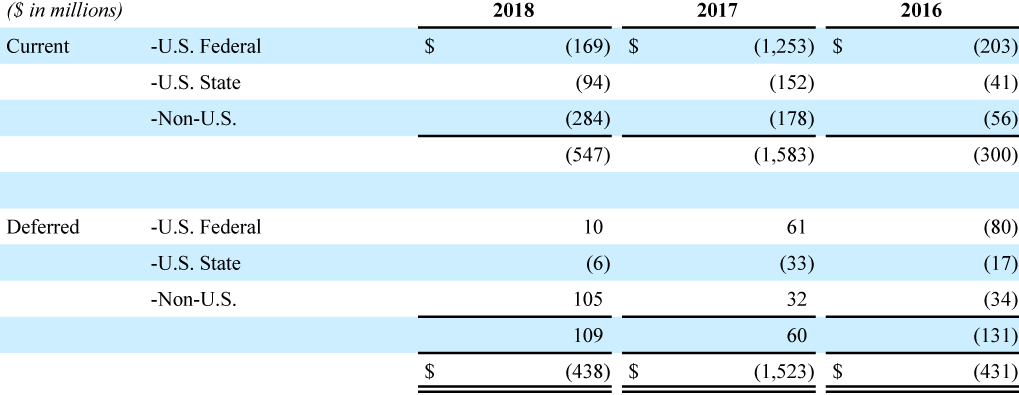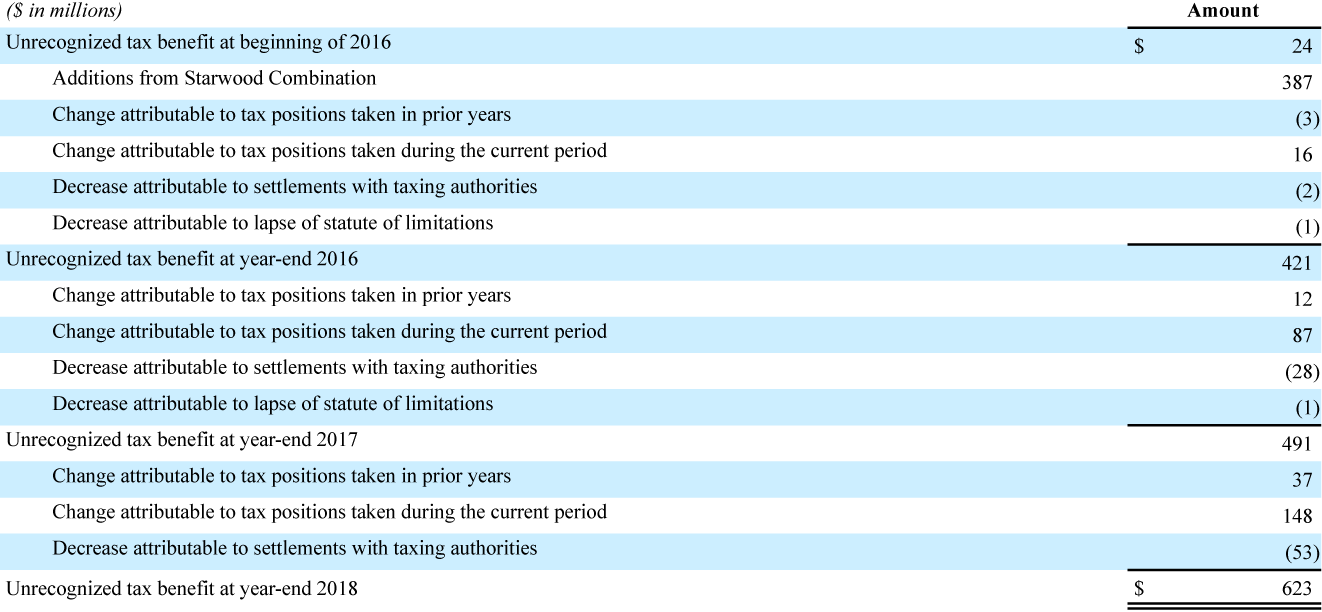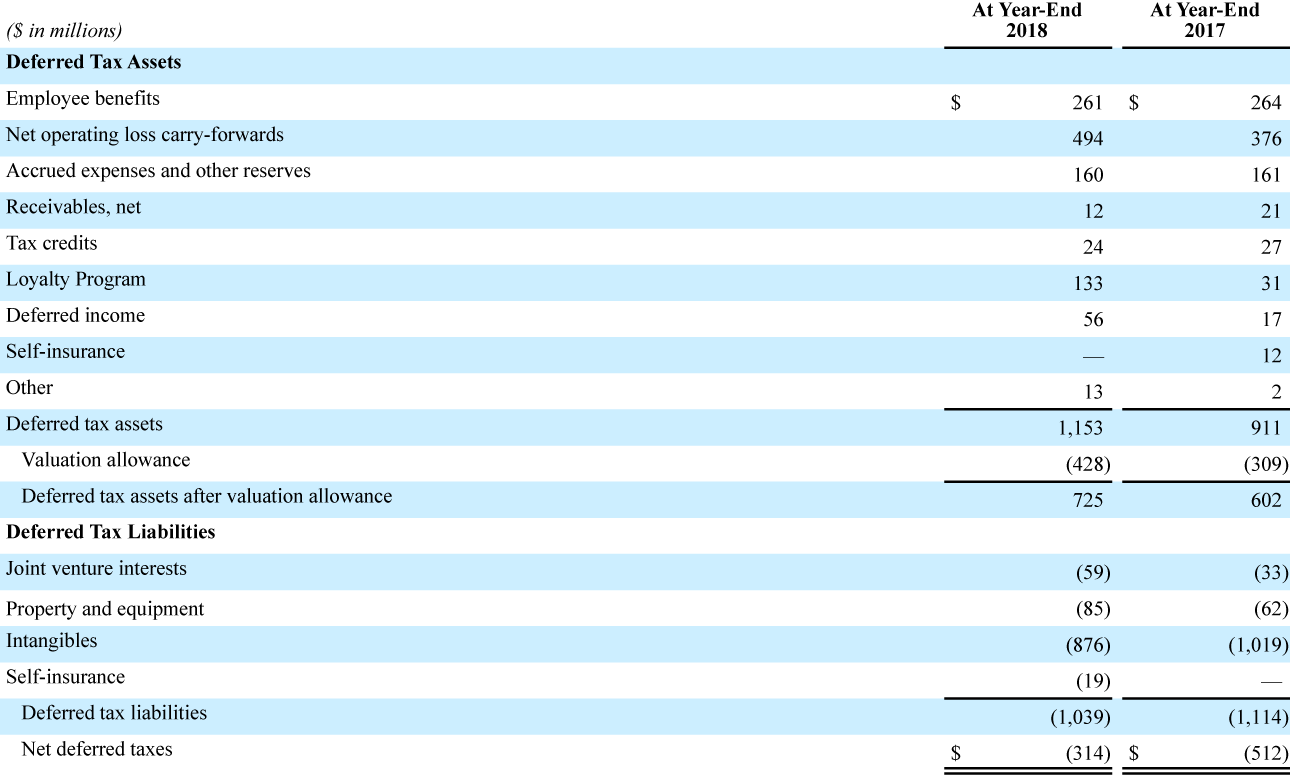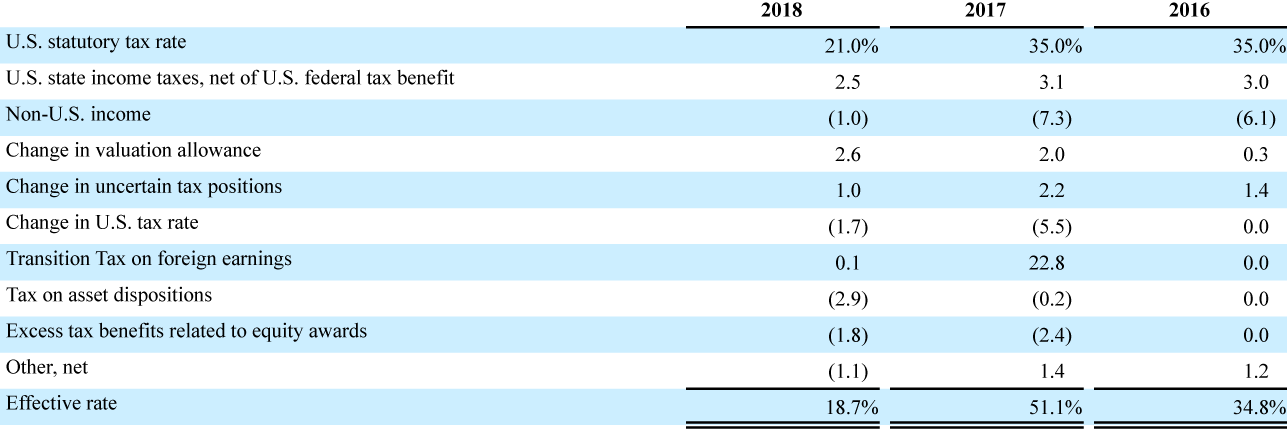Financial Information
Jump to a Section:
PART II
Item 8. Financial Statements and Supplementary Data.
MARRIOTT INTERNATIONAL, INC.
NOTES TO CONSOLIDATED FINANCIAL STATEMENTS
6. INCOME TAXES
The components of our earnings before income taxes for the last three fiscal years consisted of:

Our provision for income taxes for the last three fiscal years consists of:

Our tax provision included an excess tax benefit of $42 million in 2018 and $72 million in 2017 related to the vesting or exercise of share-based awards. Our tax provision did not reflect excess tax benefits of $32 million in 2016, as this period occurred before our adoption of ASU 2016-09. In our Statements of Cash Flows, we presented excess tax benefits as financing cash flows before our adoption of ASU 2016-09.
Unrecognized Tax Benefits
The following table reconciles our unrecognized tax benefit balance for each year from the beginning of 2016 to the end of 2018:

Our unrecognized tax benefit balances included $497 million at year-end 2018, $385 million at year-end 2017, and $288 million at year-end 2016 of tax positions that, if recognized, would impact our effective tax rate. It is reasonably possible that we will settle $243 million of unrecognized tax benefits within the next twelve months. This includes $210 million of U.S. federal issues that are currently in appeals and $33 million of state and non-U.S. audits we expect to resolve in 2019. We recognize accrued interest and penalties for our unrecognized tax benefits as a component of tax expense. Related interest totaled $3 million in 2018, $24 million in 2017, and $8 million in 2016.
We file income tax returns, including returns for our subsidiaries, in various jurisdictions around the world. The U.S. Internal Revenue Service (“IRS”) has examined our federal income tax returns, and as of year-end 2018, we have settled all issues for tax years through 2013 for Marriott and through 2009 for Starwood. Our Marriott 2014 and 2015 tax year audits are substantially complete, and our Marriott 2016 through 2018 tax year audits are currently ongoing. Starwood is currently under audit by the IRS for years 2010 through 2016. Various foreign, state, and local income tax returns are also under examination by the applicable taxing authorities.
Deferred Income Taxes
Deferred income tax balances reflect the effects of temporary differences between the carrying amounts of assets and liabilities and their tax bases, as well as from net operating loss and tax credit carry-forwards. We state those balances at the enacted tax rates we expect will be in effect when we pay or recover the taxes. Deferred income tax assets represent amounts available to reduce income taxes we will pay on taxable income in future years. We evaluate our ability to realize these future tax deductions and credits by assessing whether we expect to have sufficient future taxable income from all sources, including reversal of taxable temporary differences, forecasted operating earnings, and available tax planning strategies to utilize these future deductions and credits. We establish a valuation allowance when we no longer consider it more likely than not that a deferred tax asset will be realized.
The following table presents the tax effect of each type of temporary difference and carry-forward that gave rise to significant portions of our deferred tax assets and liabilities as of year-end 2018 and year-end 2017:

Our valuation allowance is attributable to non-U.S. and U.S. state net operating loss carry forwards. During 2018, our valuation allowance increased primarily due to net operating losses in Luxembourg.
At year-end 2018, we had approximately $11 million of tax credits that will expire through 2025 and $13 million of tax credits that do not expire. We recorded $10 million of net operating loss benefits in 2018 and $6 million in 2017. At year-end 2018, we had approximately $2,595 million of primarily state and foreign net operating losses, of which $1,712 million will expire through 2038.
Reconciliation of U.S. Federal Statutory Income Tax Rate to Actual Income Tax Rate
The following table reconciles the U.S. statutory tax rate to our effective income tax rate for the last three fiscal years:

The non-U.S. income tax benefit presented in the table above includes tax-exempt income in Hong Kong, a tax rate incentive in Singapore, a deemed interest deduction in Switzerland, and tax-exempt income earned from certain operations in Luxembourg, which collectively represented 3.4% in 2018, 6.2% in 2017, and 7.4% in 2016. We included the impact of these items in the foreign tax rate differential line above because we consider them to be equivalent to a reduction of the statutory tax rates in these jurisdictions. Pre-tax income in Switzerland, Singapore, Hong Kong, and Luxembourg totaled $432 million in 2018, $576 million in 2017, and $271 million in 2016.
The non-U.S. income tax benefit also includes 1.4% of U.S. income tax expense on non-U.S. operations. We included the impact of this tax in the non-U.S. income line above because we consider this tax to be an integral part of the foreign taxes.
Other Information
We paid cash for income taxes, net of refunds of $678 million in 2018, $636 million in 2017, and $293 million in 2016.
Tax Cuts and Jobs Act of 2017
The U.S. Tax Cuts and Jobs Act of 2017 (the “2017 Tax Act”) was enacted on December 22, 2017. The SEC had provided accounting and reporting guidance that allowed us to report provisional amounts within a measurement period up to one year from the enactment date. Complexities inherent in adopting the changes included additional guidance, interpretations of the law, and further analysis of data and tax positions. In 2018, we completed the accounting associated with the 2017 Tax Act as further described below.
Reduction of U.S. federal corporate tax rate. The 2017 Tax Act reduced the U.S. federal corporate tax rate from 35 percent to 21 percent, effective January 1, 2018. In 2017, we recorded a provisional estimated net tax benefit of $153 million for our year-end deferred tax assets and liabilities. In 2018, we completed our analyses of all impacts of the 2017 Tax Act, including, but not limited to, our calculation of deemed repatriation of deferred foreign income and the state tax effect of adjustments made to federal temporary differences, and recognized a tax benefit of $44 million.
Deemed Repatriation Transition Tax. The Deemed Repatriation Tax (“Transition Tax”) is a new one-time tax on previously untaxed earnings and profits (“E&P”) of certain of our foreign subsidiaries accumulated post-1986 through year-end 2017. In addition to U.S. federal income taxes, the deemed repatriation of such E&P also resulted in additional state income taxes in some of the U.S. states in which we operate. In 2017, we recorded a provisional estimated federal and state Transition Tax expense of $745 million. In 2018, we finalized our preliminary calculation and recorded a charge of $3 million, which includes a benefit of $5 million resulting from changes to E&P as a result of completing an IRS audit. Substantially all of our unremitted foreign earnings that have not been previously taxed have now been subjected to U.S. taxation under the Transition Tax. In 2018, we recorded a charge of $29 million for state tax liability on unremitted accumulated earnings. We have made no additional provision for U.S. income taxes or additional non-U.S. taxes on the remaining unremitted accumulated earnings of our non-U.S. subsidiaries. It is not practical at this time to determine the income tax liability related to any remaining undistributed earnings or additional basis difference not subject to the Transition Tax.
Other provisions. The 2017 Tax Act also included a new provision designed to tax GILTI. We adopted the period cost method and recorded a current provision for GILTI tax related to current-year operations in our annual effective tax rate.